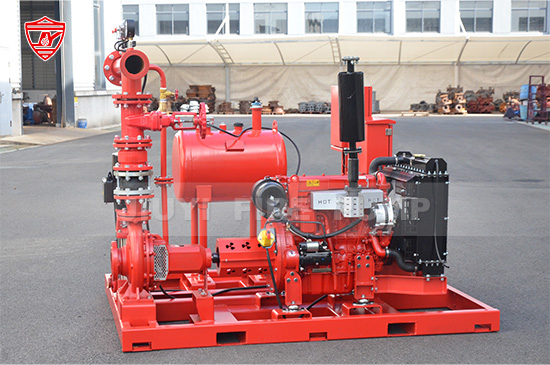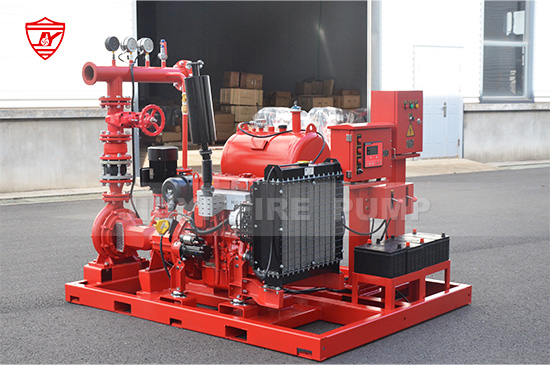Electric fire pumps are vital for fire protection systems, ensuring reliable water pressure during emergencies. However, overheating is one of the most common and dangerous issues that can compromise performance, damage equipment, or even cause system failure at critical moments. Preventing overheating requires not only proper design and installation but also consistent monitoring, maintenance, and operation in line with NFPA 20 standards.
This article’ll explore the main causes of overheating in electric fire pumps, its impact on system performance, and the most effective prevention and maintenance strategies every facility should follow.

Overheating occurs when the temperature of the electric motor or pump assembly rises beyond its safe operating range. This can happen due to several factors:
Electric fire pumps rely on proper airflow around the motor housing to dissipate heat. When installed in tight pump rooms or enclosed spaces without sufficient ventilation, heat can build up rapidly and cause the motor to overheat.
Fire pumps are designed for intermittent emergency operation. However, running them for extended periods, such as during weekly tests or in systems where they compensate for pressure losses too frequently, can lead to heat accumulation and wear. Overloading the pump—operating beyond its rated pressure or flow—also generates excess heat.
Issues such as voltage imbalance, loose wiring, or faulty connections can cause uneven current distribution across motor windings. This not only reduces efficiency but also raises motor temperature, accelerating insulation degradation.
Worn bearings or misalignment between the motor and pump shaft create mechanical resistance. The resulting friction increases heat output and may cause the pump to seize if not corrected in time.
In many installations, electric fire pumps rely on cooling water or ambient airflow. Blocked cooling lines, dirty filters, or failed fans reduce the ability to transfer heat away from the motor and bearings.
Overheating is not just a maintenance issue—it’s a reliability and safety concern. The potential consequences include:
Motor Damage: Excessive heat weakens insulation on motor windings, leading to short circuits or motor failure.
Reduced Pump Efficiency: Overheating increases internal friction and decreases overall hydraulic performance.
Unexpected System Shutdown: High motor temperature may trigger automatic protection devices, cutting power supply during critical fire emergencies.
Shortened Equipment Lifespan: Every 10°C increase above the motor’s rated temperature can halve its service life.
Increased Maintenance Costs: Frequent repairs and replacements add unnecessary operational expenses.
Therefore, preventing overheating is not only about equipment protection—it’s about ensuring that your fire protection system functions reliably when lives and property are at stake.
To keep electric fire pumps operating safely, consistent attention to design, installation, and maintenance practices is essential. Below are the most effective measures to prevent overheating.
The pump room should be designed with sufficient ventilation openings to allow free airflow. Install exhaust fans or air-conditioning systems to maintain ambient temperature within the motor’s rated range (usually below 40°C).
Keep at least one meter of clearance around the motor for unrestricted airflow.
Avoid installing pumps in confined spaces without forced ventilation.
Periodically clean dust, dirt, and debris from ventilation grilles and louvers.
Regularly monitor the load on the electric motor using ammeters or monitoring systems. Operating near or above the rated current for long durations increases the risk of overheating.
Verify that the pump operates at its rated duty point.
Adjust system valves and pressure settings according to NFPA 20 requirements.
Avoid frequent on/off cycling of the motor to reduce electrical stress.
Ensure the incoming power supply matches the motor’s voltage and phase requirements. Voltage imbalance exceeding 2% can cause uneven current flow, leading to excessive heating in one phase.
Inspect wiring, terminals, and control panels regularly for signs of wear, looseness, or corrosion.
Tighten all electrical connections during scheduled maintenance.
Replace damaged cables or insulation immediately.
Bearings are critical for smooth pump operation. Misalignment or lubrication failure generates additional friction and heat.
Perform regular vibration analysis to detect misalignment or imbalance.
Check bearing temperature during pump testing; it should not exceed manufacturer limits.
Use high-quality lubricants recommended for fire pump service and avoid over-greasing.
If the fire pump motor has a dedicated cooling system, ensure it operates correctly. Check the following:
Cooling water supply lines are clear and free of obstructions.
Fans and air filters are clean and functional.
Temperature sensors and alarms are calibrated and responsive.
For water-cooled systems, inspect the water quality regularly to prevent scale buildup or corrosion that can reduce heat transfer efficiency.
A well-structured maintenance program is the foundation of overheating prevention. Follow the inspection frequency recommended by NFPA 25 and the pump manufacturer.
Conduct weekly pump tests, but limit continuous operation to prevent excessive heat buildup.
Record motor current, voltage, and temperature readings during each test.
Perform annual insulation resistance testing to detect early signs of winding degradation.
Modern fire pump systems can be equipped with smart monitoring solutions that provide continuous temperature, vibration, and performance data.
Use thermal sensors to monitor critical components.
Integrate alerts that notify operators when temperature approaches threshold levels.
Connect monitoring data to facility management systems for trend analysis and predictive maintenance.
Proper installation plays a major role in preventing future overheating problems. Here are several best practices to follow during setup:
Select the Correct Motor Size: Oversized or undersized motors can both contribute to inefficiency and temperature rise. Match the motor power precisely to the pump load.
Ensure Alignment and Foundation Stability: The pump and motor should be perfectly aligned and mounted on a stable base to minimize vibration and heat generation.
Provide Thermal Protection Devices: Use temperature sensors, overload relays, or thermistors integrated with the controller to automatically shut down the pump in case of overheating.
Insulate Electrical Components: Protect cables and terminals from environmental heat or moisture to prevent conductivity loss.
Recognizing early warning signs can help prevent major damage. Common indicators include:
Unusual smell of burning insulation
Motor casing feels excessively hot to touch
Unstable current or voltage readings
Reduced water flow or pressure
Unexpected system shutdown or tripped circuit breakers
If these symptoms appear, immediately stop the pump and investigate the root cause before restarting. Continuous operation under these conditions can cause irreversible damage.
NFPA 20 provides detailed requirements for the installation of stationary fire pumps for fire protection. Compliance ensures that the pump operates within safe parameters, minimizing overheating risks. The standard specifies:
Adequate ventilation and cooling provisions
Correct motor sizing and protection devices
Proper alignment and foundation for all rotating equipment
Following NFPA 20 guidelines not only enhances system safety but also ensures long-term operational reliability.

Overheating in electric fire pumps is a preventable issue when addressed through proper design, installation, and ongoing maintenance. By ensuring effective ventilation, monitoring electrical balance, maintaining bearings and cooling systems, and complying with NFPA 20 standards, facilities can significantly reduce the risk of motor failure and maintain full fire protection readiness.
Remember, a fire pump is not just another piece of machinery—it’s the heart of your building’s fire protection system. Preventing overheating means protecting lives, property, and your investment in safety.